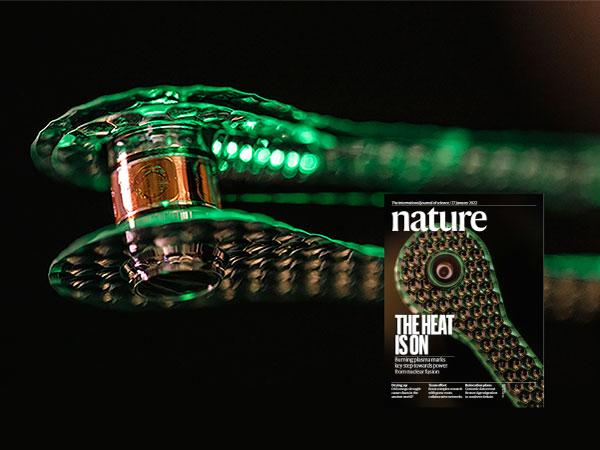
A cryogenic target used for experiments producing burning-plasma conditions.
Photo: Jason Laurea, Lawrence Livermore National Laboratory
The PSFC researchers answer 4 questions about the recent fusion experiments that led to the honor
February 10, 2022
Plasma Science and Fusion Center (PSFC) Research Scientist Maria Gatu Johnson and Senior Research Scientist and HEDP division head Johan Frenje were part of a team who won the NNSA Secretary's Honor Award for the achievement of a Burning Plasma at the Lawrence Livermore National Laboratory's National Ignition Facility (NIF), which was published recently in Nature and appeared on the Journal's front cover. The award ceremony, held virtually on January 11, 2022, was honored by the attendance of U.S. Department of Energy Secretary Jennifer Granholm and Under Secretary for Nuclear Security and Administrator of the National Nuclear Security Administration Jill Hruby.
What do the latest reported results at NIF show?
Frenje: The results represent the first demonstration of laser-driven fusion plasmas reaching the ‘burning regime,’ where plasma heating by the fusion reactions themselves is the main heating source — this is a key requirement for self-sustaining fusion energy and ignition. This is discussed in the Nature paper by Zylstra et al. The companion Nature Physics paper by Kritcher et al. discussed in detail the process for optimizing the experimental design.
Why is this important?
Frenje: This milestone demonstrates for the first time that the plasma can supply its own heat, indicating that a controlled burning plasma can be achieved in a laboratory. In addition, the achievements advance our understanding of the physics of burning and self-heating plasmas, enabling a whole range of scientific studies in several areas of research. Some of these pursuits will be key to national security and Inertial Fusion Energy.
How did MIT contribute to this success?
Gatu Johnson: Over the past decades MIT’s PSFC has contributed to the success of this inertial confinement fusion (ICF) experiment at the NIF, providing about a dozen diagnostics, many implemented by MIT PhD students, critical to assessing the implosion performance. One of the most important of these systems is the Magnetic Recoil neutron Spectrometer (MRS). We have used this spectrometer extensively for more than a decade to measure the neutron energy spectrum of the implosion, from which we determine the number of fusion reactions, temperature of the plasma, and how well the fuel is compressed in an implosion. The MRS data have been essential in identifying key issues with the implosions and for guiding the campaigns at the NIF towards the conditions required for ignition.
What are the next steps for NIF and MIT?
Gatu Johnson: The next step for MIT is to develop the next-generation neutron diagnostics in support of the ignition campaign at the NIF. This will be done by implementing and using the MRS for time-resolved measurements of the neutron spectrum, from which the evolution of ion temperature, compression and alpha heating and burn will be diagnosed for the first time.
Topics: Plasma science, Technology & engineering, High-energy-density physics